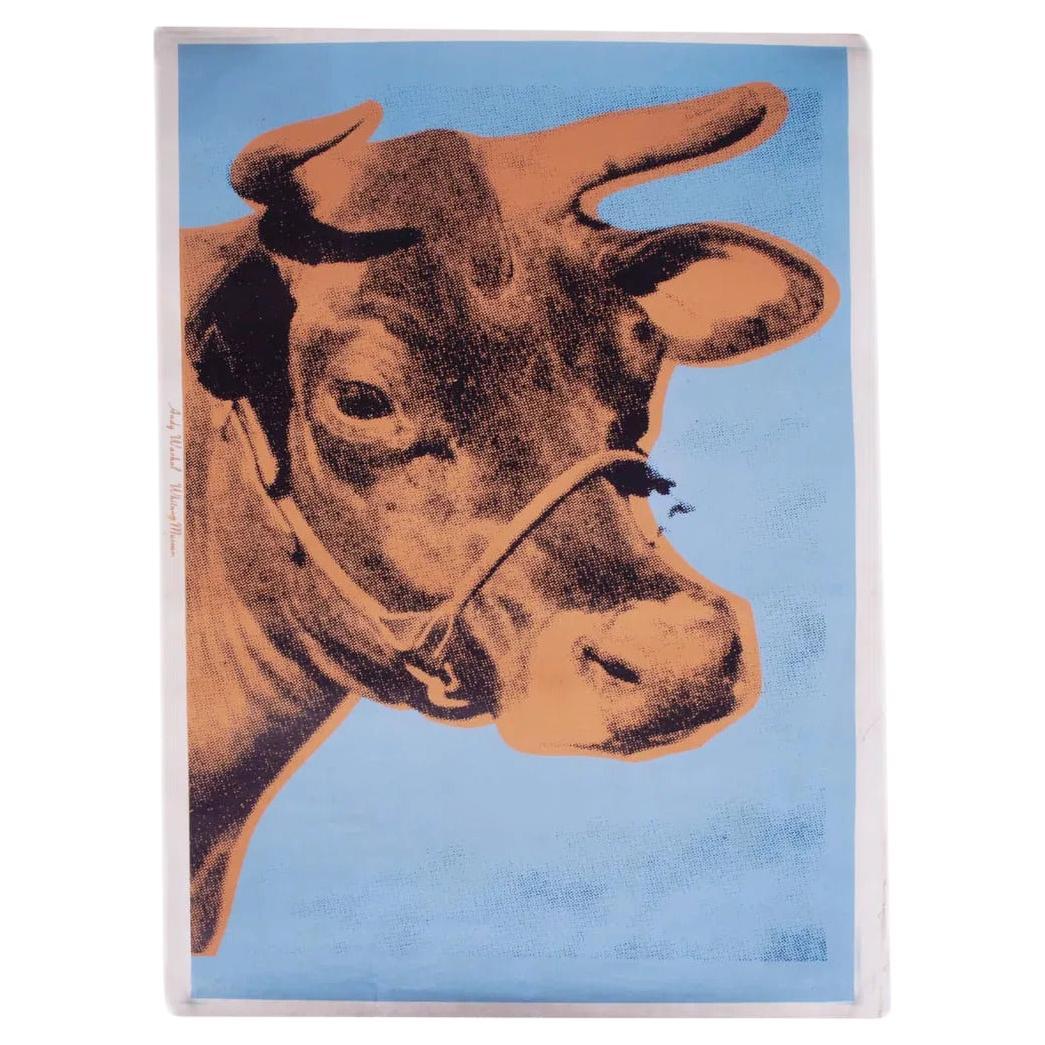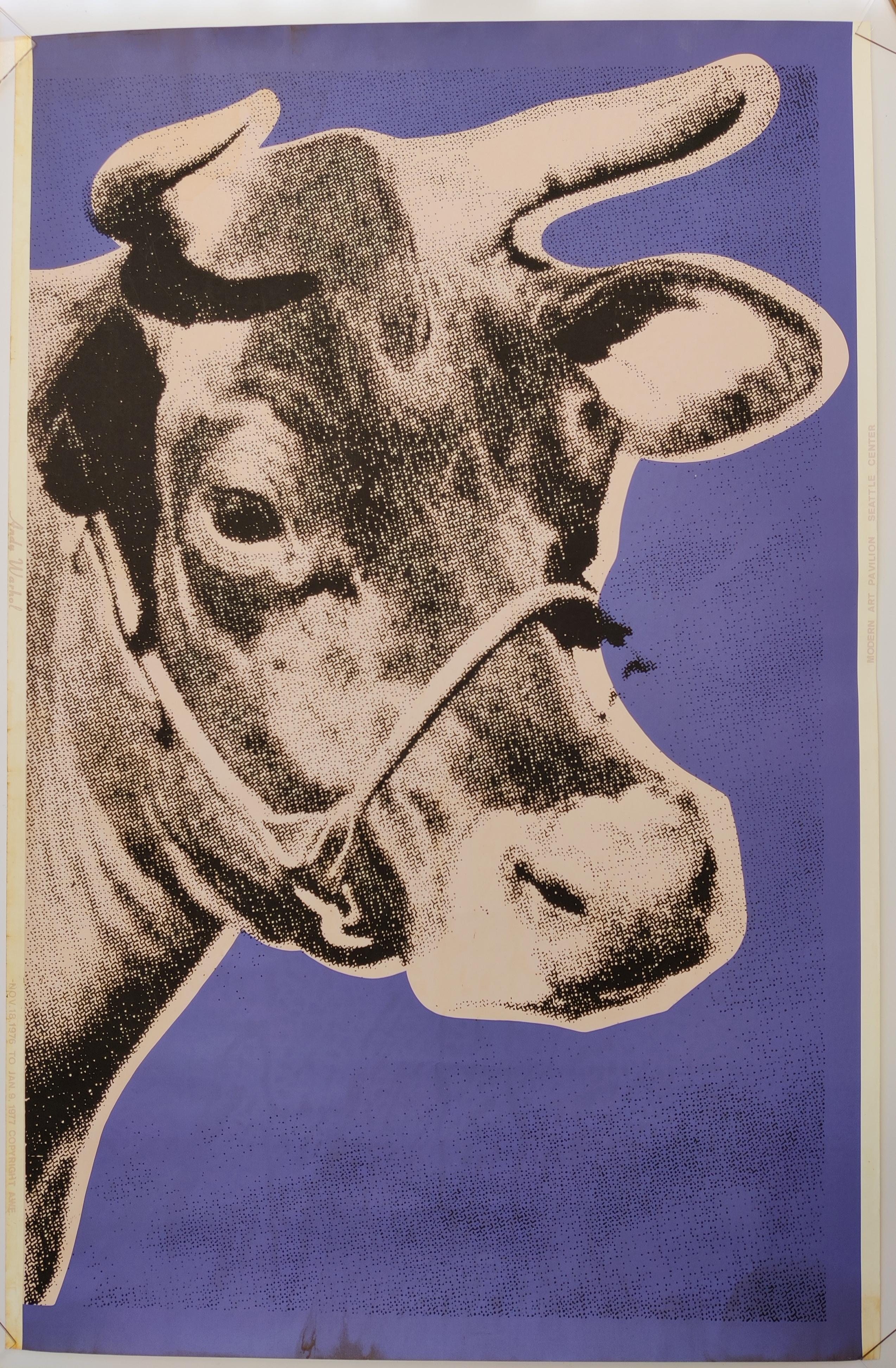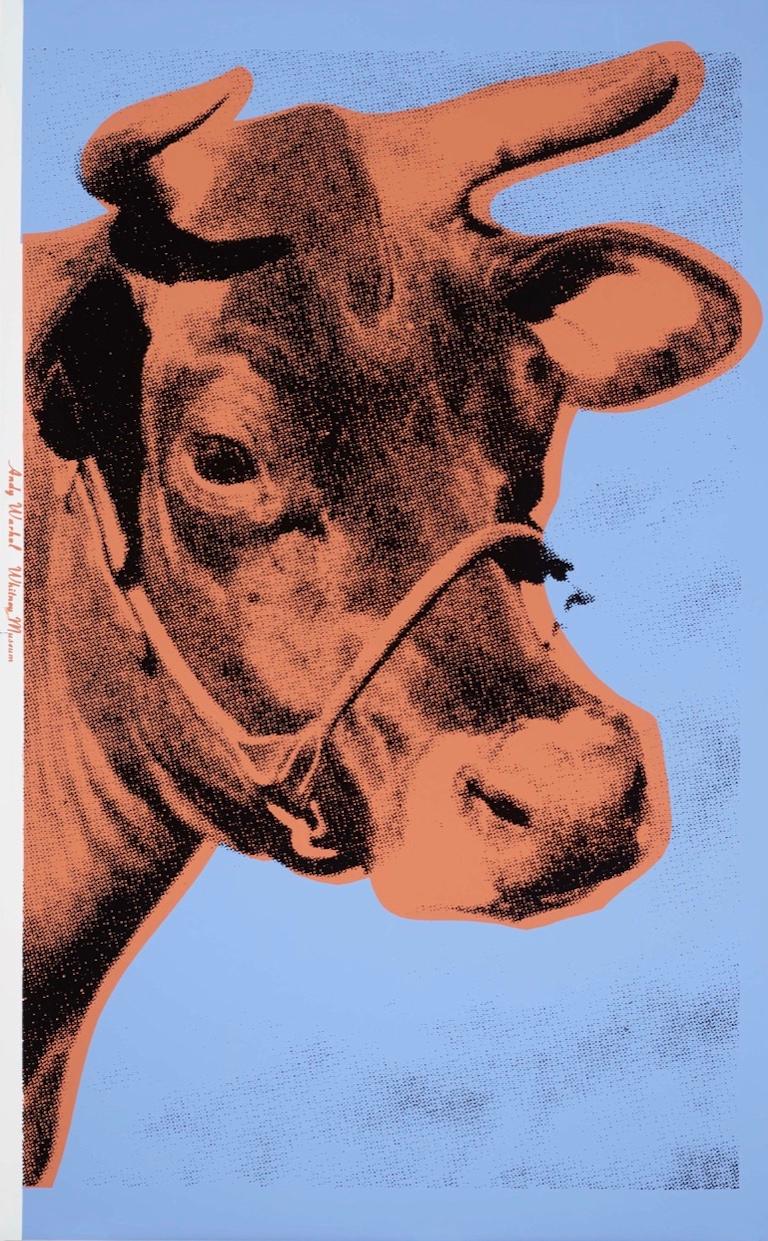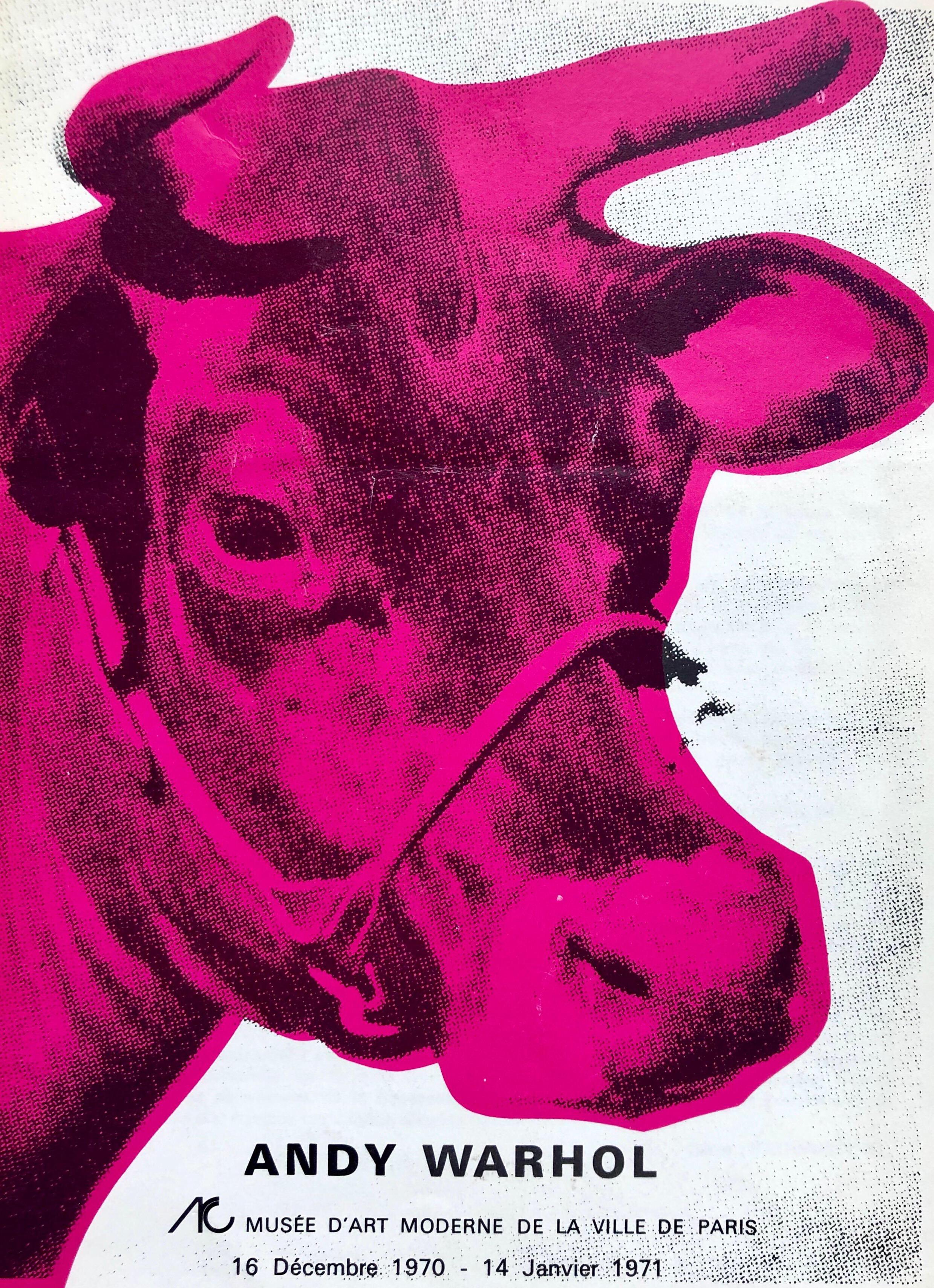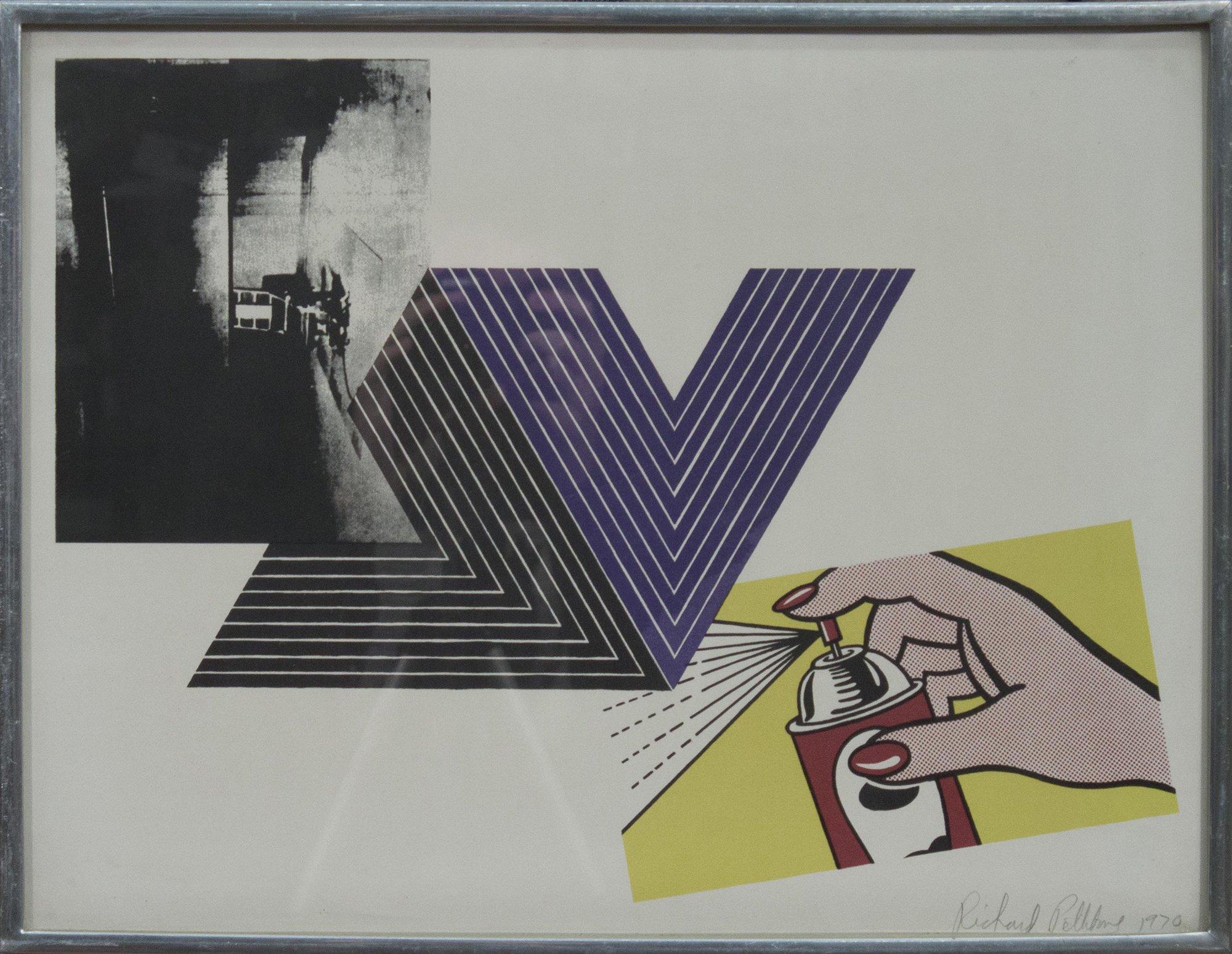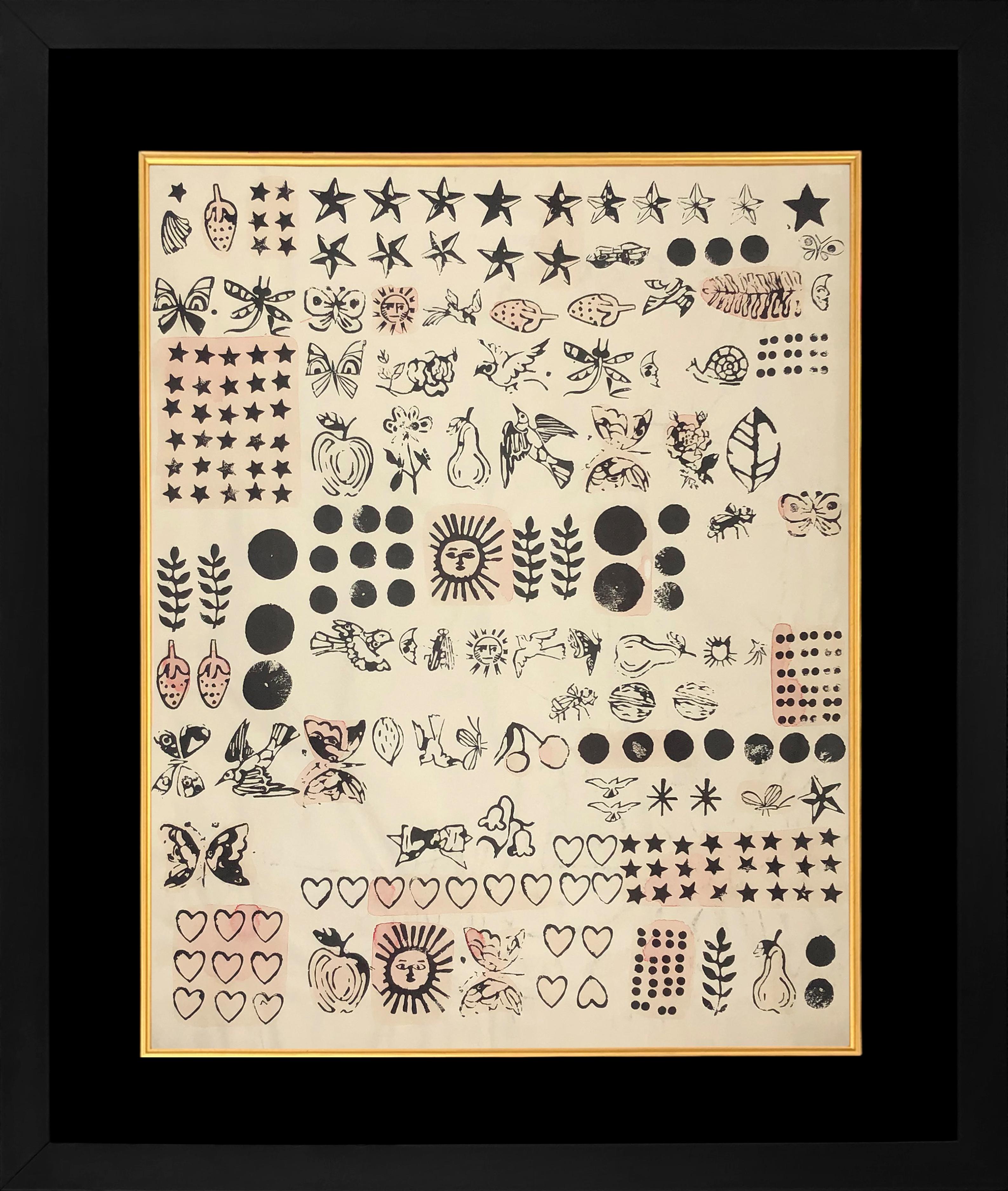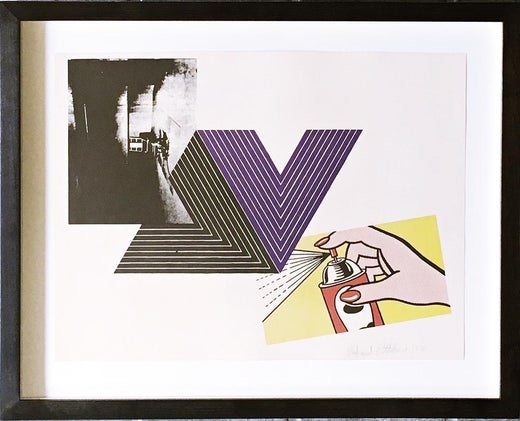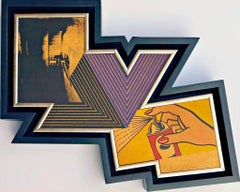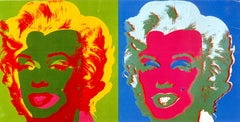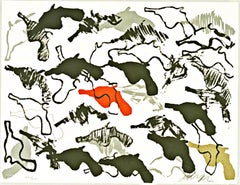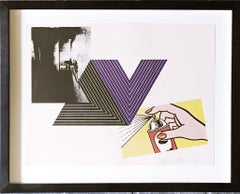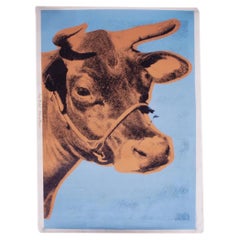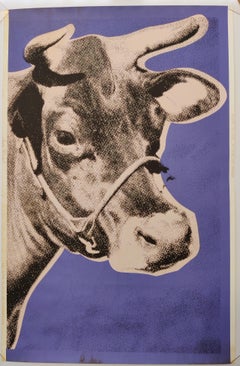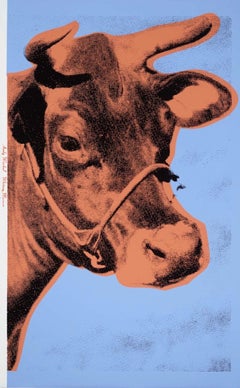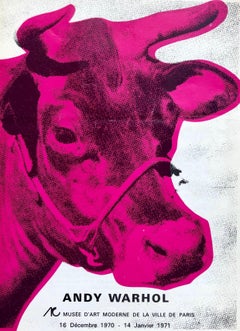Items Similar to Pettibone's Andy Warhol Cow Wallpaper, pencil signed famed appropriation print
Want more images or videos?
Request additional images or videos from the seller
1 of 7
Richard PettibonePettibone's Andy Warhol Cow Wallpaper, pencil signed famed appropriation print1971
1971
$5,000
£3,785.48
€4,384.03
CA$7,076.14
A$7,928.14
CHF 4,122.98
MX$96,055.36
NOK 52,528.56
SEK 49,037.23
DKK 32,725.83
About the Item
Richard Pettibone
Andy Warhol Cow Wallpaper
Silkscreen on paper
26 1/2 × 20 3/4 inches
Hand Signed and dated in graphite on the front
Unframed
Accompanied by Gallery issued Certificate of Guarantee
More about RIchard Pettibone:
With his mini-reproductions of significant works of art since the 1960s, Richard Pettibone (born 1938 in Alhambra, California) is considered a pioneer of Appropriation Art. He made the appropriation of images his own long before it became a common artistic practice in the 1980s. Pettibone copied paintings by Andy Warhol, Jasper Johns, Frank Stella, Roy Lichtenstein or Ed Ruscha as well as works by Marcel Duchamp or Piet Mondrian. His "reductions", as Pettibone calls them, differ from their "pre-images" in their greatly reduced size and subtle modifications, such as colour or material changes. Oscillating between original and reproduction, questions about the authorship of works and ideas open up, not without including the commercialisation of art, the art market and the role of the artist in the discourse. Major exhibition houses, such as the Whitney Museum of American Art, New York; the Laguna Art Museum, Laguna Beach; and the Pasadena Art Museum (now the Norton Simon Museum), Pasadena have presented solo exhibitions of Pettibone
- Creator:Richard Pettibone (1938, American)
- Creation Year:1971
- Dimensions:Height: 26.5 in (67.31 cm)Width: 20.75 in (52.71 cm)
- Medium:
- Movement & Style:
- Period:
- Condition:
- Gallery Location:New York, NY
- Reference Number:1stDibs: LU1745213480822
Richard Pettibone
Richard Pettibone was one of the pioneering artists to use appropriation techniques. Pettibone was born in Los Angeles, and first worked with shadow boxes and assemblages, illustrating his interest in craft, construction, and working in miniature scales.
(Biography provided by ArtWise)
About the Seller
5.0
Platinum Seller
Premium sellers with a 4.7+ rating and 24-hour response times
Established in 2007
1stDibs seller since 2022
446 sales on 1stDibs
Typical response time: 2 hours
- ShippingRetrieving quote...Shipping from: New York, NY
- Return Policy
Authenticity Guarantee
In the unlikely event there’s an issue with an item’s authenticity, contact us within 1 year for a full refund. DetailsMoney-Back Guarantee
If your item is not as described, is damaged in transit, or does not arrive, contact us within 7 days for a full refund. Details24-Hour Cancellation
You have a 24-hour grace period in which to reconsider your purchase, with no questions asked.Vetted Professional Sellers
Our world-class sellers must adhere to strict standards for service and quality, maintaining the integrity of our listings.Price-Match Guarantee
If you find that a seller listed the same item for a lower price elsewhere, we’ll match it.Trusted Global Delivery
Our best-in-class carrier network provides specialized shipping options worldwide, including custom delivery.More From This Seller
View AllRichard Pettibone The Appropriation Warhol, Stella, Lichtenstein, Unique Signed
By Richard Pettibone
Located in New York, NY
Richard Pettibone
The Appropriation Print Andy Warhol, Frank Stella, Roy Lichtenstein, 1970
Silkscreen in colors on masonite board (unique variant on sculpted board)
Hand-signed by artist, Signed and dated on the front (see close up image)
Bespoke frame Included
This example of Pettibone's iconic Appropriation Print is silkscreened on masonite board rather than paper, giving it a different background hue, and enabling it work to be framed so uniquely.
The Appropriation print is one of the most coveted prints Pettibone ever created ; the regular edition is on a full sheet with white background; the present example was silkscreened on board, allowing it to be framed in 3-D. While we do not know how many examples of this graphic work Pettibone created, so far the present work is the only one example we have ever seen on the public market since 1970. (Other editions of The Appropriation Print have been printed on vellum, wove paper and pink and yellow paper.)
This 1970 homage to Andy Warhol, Frank Stella and Roy Lichtenstein exemplifies the type of artistic appropriation he was engaging in early on during the height of the Pop Art movement - long before more contemporary artists like Deborah Kass, Louise Lawler, etc. followed suit.
This silkscreen was in its original 1970 vintage period frame; a bespoke custom hand cut black wood outer frame was subsequently created especially to house the work, giving it a distinctive sculptural aesthetic.
Measurements:
Framed 14.5 inches vertical by 18 inches horizontal by 2 inches
Work
13 inches vertical by 16.5 inches horizontal
Richard Pettibone biography:
Richard Pettibone (American, b.1938) is one of the pioneering artists to use appropriation techniques. Pettibone was born in Los Angeles, and first worked with shadow boxes and assemblages, illustrating his interest in craft, construction, and working in miniature scales. In 1964, he created the first of his appropriated pieces, two tiny painted “replicas” of the iconic Campbell’s soup cans by Andy Warhol (American, 1928–1987). By 1965, he had created several “replicas” of paintings by American artists, such as Warhol, Roy Lichtenstein (1923–1997), Ed Ruscha (b.1937), and others, among them some of the biggest names in Pop Art. Pettibone chose to recreate the work of leading avant-garde artists whose careers were often centered on themes of replication themselves, further lending irony to his work. Pettibone also created both miniature and life-sized sculptural works, including an exact copy of Bicycle Wheel by Marcel Duchamp (French, 1887–1968), and in the 1980s, an entire series of sculptures of varying sizes replicating the most famous works of Constantin Brancusi (Romanian, 1876–1957). In more recent years, Pettibone has created paintings based on the covers of poetry books by Ezra Pound, as well as sculptures drawn from the grid compositions of Piet Mondrian (Dutch, 1872–1944). Pettibone straddles the lines of appropriation, Pop, and Conceptual Art, and has received critical attention for decades for the important questions his work raises about authorship, craftsmanship, and the original in art. His work has been exhibited at the Institute for Contemporary Art in Philadelphia, the Museum of Modern Art in New York, the Museum of Contemporary Art in Miami, and the Laguna Art Museum in Laguna Beach, CA. Pettibone is currently based in New York.
"I wished I had stuck with the idea of just painting the same
painting like the soup can and never painting another painting.
When someone wanted one, you would just do another one.
Does anybody do that now?"
Andy Warhol, 1981
Since the mid-1960s, Richard Pettibone has been making
hand-painted, small-scale copies of works by other artists — a
practice due to which he is best known as a precursor of appropriation art — and for a decade now, he has been revisiting subjects from across his career. In his latest exhibitions at
Castelli Gallery, Pettibone has been showing more of the “same”
paintings that had already been part of his 2005–6 museum retrospective,1
and also including “new” subject matter drawn from
his usual roster of European modernists and American postwar
artists. Art critic Kim Levin laid out some phases of the intricate spectrum from copies to repetitions in her review of the
Warhol-de Chirico showdown, a joint exhibition at the heyday
of appropriation art in the mid-1980s when Warhol’s appropriations of de Chirico’s work effectively revaluated “the grand
old auto-appropriator”.
Upon having counted well over a dozen
Disquieting Muses by de Chirico, Levin speculated: “Maybe he
kept doing them because no one got the point. Maybe he needed the money. Maybe he meant it when he said his technique
had improved, and traditional skills were what mattered.”
On
the other side, Warhol, in her eyes, was the “latter-day exemplar
of museless creativity”.
To Pettibone, traditional skills certainly
still matter, as he practices his contemporary version of museless creativity. He paints the same painting again and again,
no matter whether anybody shows an interest in it or not. His
work, of course, takes place well outside the historical framework of what Levin aptly referred to as the “modern/postmodern wrestling match”,
but neither was this exactly his match
to begin with.
Pettibone is one of appropriation art’s trailblazers, but his diverse
selection of sources removes from his work the critique of the
modernist myth of originality most commonly associated with
appropriation art in a narrow sense, as we see, for example, in
Sherrie Levine’s practice of re-photographing the work of Walker
Evans and Edward Weston. In particular, during his photorealist
phase of the 1970s, Pettibone’s sources ranged widely across
several art-historical periods. His appropriations of the 1980s
and 1990s spanned from Picasso etchings and Brancusi sculptures to Shaker furniture and even included Ezra Pound’s poetry.
Pettibone has professed outright admiration for his source artists, whose work he shrinks and tweaks to comic effect but, nevertheless, always treats with reverence and care. His response
to these artists is primarily on an aesthetic level, owing much
to the fact that his process relies on photographs. By the same
token, the aesthetic that attracts him is a graphic one that lends
itself to reproduction. Painstakingly copying other artists’ work by hand has been a way of making
it his own, yet each source is acknowledged in
his titles and, occasionally, in captions on white
margins that he leaves around the image as an
indication that the actual source is a photographic image. The enjoyment he receives in copying
is part of the motivation behind doing it, as is
the pleasure he receives from actually being with
the finished painting — a considerable private
dimension of his work. His copies are “handmade
readymades” that he meticulously paints in great quantities in his studio upstate in New York; the commitment
to manual labor and the time spent at material production has
become an increasingly important dimension of his recent work.
Pettibone operates at some remove from the contemporary art
scene, not only by staying put geographically, but also by refusing to recoup the simulated lack of originality through the
creation of a public persona.
In so doing, Pettibone takes a real
risk. He places himself in opposition to conceptualism, and he is
apprehensive of an understanding of art as the mere illustration
of an idea. His reading of Marcel Duchamp’s works as beautiful
is revealing about Pettibone’s priorities in this respect.
When
Pettibone, for aesthetic pleasure, paints Duchamp’s Poster for
the Third French Chess...
Category
1970s Pop Art Abstract Prints
Materials
Masonite, Pencil, Screen
Exclusive Invitation Card to Andy Warhol Memorial Lunch from Estate of Tim Hunt
By Andy Warhol
Located in New York, NY
SUPER RARE!
Invitation Card to private Andy Warhol Memorial Lunch, from the Estate of Tim Hunt, 1987
Offset lithograph card
6 1/2 × 3 3/5 inches
Unframed
This exclusive invitation to the private memorial lunch for Andy Warhol is an historic collectors item. Few people in the world own this card other than those who were invited to the event and/or their heirs, though it has occasionally appeared at public auction now that another generation has passed. This offset lithograph invitation card to Andy Warhol's Memorial Lunch at the Diamond Horseshoe in the Paramount Hotel bears an image of Andy Warhol's iconic 1967 Marilyn on one side, and on the other side is an announcement that reads as follows:
ANDY WARHOL
A Memorial Lunch
Wednesday, April 1, 1987
The Diamond Horseshoe
235 West 46th Street
New York City
Special thanks to:
Carillon Importers
Caffe Condotti
Glorious Food
All leftover food and flowers will be donated to the homeless program at Church of the Heavenly Rest.
Marilyn - Andy Warhol 1967
The provenance of this card is impressive as it comes from the estate of Warhol Foundation curator and sales agent Tim Hunt, who was married to bestselling author Tama Janowitz, author of "Slaves of New York". Tama would describe how she met Tim Hunt as follows: "Andy Warhol died in 1987. In the long hot summer after, I bought a tiny basement apartment on West 70th Street over by West End Ave. That’s when I met Tim Hunt. A model for Werther’s Caramel and Ralph Lauren who’d gone to Oxford and had a brother who was a famous race car driver, he’d been with Christie’s a few years and had come over from England to work on the Warhol estate. He would later become my husband. Andy would have loved Tim. But the two had never met..."
The event in this invitation is the more exclusive Memorial Lunch on April 1st 1987, held prior to Warhol's Memorial Mass at St. John the Divine, later that evening, the latter of which was attended by thousands of people. The press referred to this earlier event as a "Special Memorial Lunch Party" - using the vernacular of the day, as everything in the mid to late 1980s seemed like a party - until it was not. Interestingly, no start time, or even time range, is mentioned on this invitation - something that is rarely if ever missing from such an item; further evidence that it wasn't enough just to get this card; one had to already be in the know to be able to attend. Either that, or the lunch party was going on all day - so invitees could show up whenever they wanted. Or, alternatively, it was simply an accidental omission with no hidden message. And another side note: one of the sponsors of this Memorial luncheon, Carillon Importers, is the holding company or importer for Absolut Vodka, which commissioned Andy Warhol to create a series of advertising ads that would comprise one of the most successful, award-winning advertising campaigns of the era - and the most successful of the company's history. Who attended this event? Probably everybody who was anybody in the nexis of art, celebrity, high fashion and big business. Getty images features photographs by celebrity paparazzo Ron Galella of some of Warhol pals entering or leaving the Diamond Horseshoe for this exclusive event including Dianne Brill...
Category
1980s Pop Art Figurative Prints
Materials
Lithograph, Offset
Boom Boom (Guns) mid century print, New York International portfolio S/N 1960s
By Arman
Located in New York, NY
Arman
Boom Boom (unique variation from New York International Portfolio), 1965
Screenprint with pencil additions.
Pencil signed and numbered 12/225 on the front
Published by Chiron ...
Category
1960s Pop Art Abstract Prints
Materials
Screen
Pop Art Appropriation Print: Andy Warhol, Frank Stella, Roy Lichtenstein, SIGNED
By Richard Pettibone
Located in New York, NY
Richard Pettibone
The Appropriation Print: Andy Warhol, Frank Stella, Roy Lichtenstein, 1970
(Andy Warhol's Electric Chair, Frank Stella's Empress of India and Roy Lichtenstein's Spray)
Silkscreen in colors on smooth wove paper
Pencil signed and dated 1971 on the front
Frame included:
Elegantly floated and framed in a white wood frame under UV plexiglass in accordance with museum conservation standards
Measurements:
frame: 15 7/8 x 19 3/4 x 1 3/4 inches
sheet: 12 1/4 x 16 inches
This is one of Richard Pettibone's most iconic, popular and desirable prints done in 1970 - during the most influential era of the Pop Art movement. This homage to Andy Warhol, Frank Stella and Roy Lichtenstein exemplifies the type of artistic appropriation he was engaging in early on during the height of the Pop Art movement - long before more contemporary artists like Deborah Kass, Louise Lawler, etc. followed suit. Pencil signed and dated recto. It was created in limited edition - though the exact number is not known.
More about RIchard Pettibone:
As a young painter, Richard Pettibone began replicating on a miniature scale works by newly famous artists, and later also modernist masters, signing the original artist’s name as well as his own. His versions of Andy Warhol’s soup...
Category
1970s Pop Art Abstract Prints
Materials
Screen, Pencil
Art About Art, historic Whitney Museum of American Pop Art lithographic poster
By Roy Lichtenstein
Located in New York, NY
Roy Lichtenstein
Art About Art Whitney Museum of American Art 1978 poster, 1978
Offset lithograph poster
Frame included: held in the original vintage frame
Provenance:
from the colle...
Category
1970s Pop Art Abstract Prints
Materials
Lithograph, Offset
Rare historic print (broadside) for 1971 Andy Warhol Gotham Bookmart exhibition
By Andy Warhol
Located in New York, NY
Andy Warhol
Rare broadside for Gotham Bookmart exhibition "Andy Warhol His Early Works, 1947 - 1959", 1971
Offset lithograph poster
18 × 12 1/2 inches
Unframed (not signed)
Accompan...
Category
1970s Pop Art Figurative Prints
Materials
Lithograph, Offset
You May Also Like
Andy Warhol, "Cow" Lithograph on Linen
By (after) Andy Warhol
Located in Wichita, KS
Andy Warhol "Cow" lithograph laid on linen in blue and orange. From Andy Warhol's Cow series, which featured various color combinations of cow profiles silkscreened atop wallpaper. ...
Category
20th Century American Post-Modern Prints
Materials
Linen, Paper
$1,220 / item
Andy Warhol -- Cow, 1971
By Andy Warhol
Located in BRUCE, ACT
Andy Warhol
Cow , 1971
Silkscreen on wallpaper, unsigned
Cow with a soft pink background, surrounded by a purple ground.
Left margin in the same soft pink reading "Andy Warhol" and...
Category
1970s Prints and Multiples
Materials
Screen
$10,164 Sale Price
40% Off
Andy Warhol 'Cow' 1971
By Andy Warhol
Located in Miami, FL
ANDY WARHOL (1928-1987)
Andy Warhol's 'Cow' (F&S.II.11A) is a 1971 screenprint, on wallpaper with trimmed margins. This unsigned print comes from a publication of an unknown size (aside from approx. 100 signed impressions), printed by Bill Miller...
Category
1970s Contemporary Prints and Multiples
Materials
Screen
Andy Warhol Musee d’Art Moderne catalog (Warhol Cow)
By Andy Warhol
Located in NEW YORK, NY
Andy Warhol Paris, Musee d’Art Moderne de la Ville de Paris, 1970:
Rare original Andy Warhol exhibition catalog featuring a Warhol Pink Cow cover.
Published on the occasion of the Warhol solo show at the MAM, Paris, Dec. 16, 1970 - Jan. 14, 1971. A must have rare vintage Andy Warhol Cows collectible.
1st edition; 1970. Single sheet folded, twelve-page accordion style booklet. Text by Alfred Pacquement (French). Exhibition checklist found within. Reverse features a candid, black and white portrait of Warhol.
Medium: Offset printed Exhibition Catalog.
Dimensions: Folded 7.75 × 10.5 inches; Unfolded: 7.75 x 47 inches.
Condition: Very good overall vintage condition; hand written notations to interior first page.
Unsigned from edition of unknown.
Further Background:
Andy Warhol was inspired to by art dealer Ivan Karp to create his Cows in the 1960s. Warhol’s printer Gerard Malanga chose the photograph of the cow, however it was Warhol’s unique pop art style that made the final product so interested. He chose a bold color scheme of bright pink on yellow, which turned the pastoral animal into an amusing and oddly exciting subject matter. Warhol then printed the electrifying Cow image on wallpaper, introducing this process to his creative production. In Warhol’s classic mode of repetition, every inch of the walls were covered with hot pink and yellow Cows. Castelli was so moved by the show, that he had professionals install the wallpaper so that the guests could experience Andy Warhol’s vision.
_
Obsessed with celebrity, consumer culture, and mechanical reproduction, Pop Art king, Andy Warhol created some of the 20th century’s most iconic images. Warhol was widely influenced by popular & consumer culture, with this being evident in some of his most famous works: 32 Campbell's soup cans, Brillo pad box sculptures, and portraits of Marilyn Monroe & Mick Jagger, for example. Rejecting the standard painting and sculpting modes of his era, Warhol embraced silk-screen printmaking to achieve his characteristic hard edges and flat areas of color. The artist mentored Keith Haring and Jean-Michel Basquiat and continues to influence contemporary art around the world: His most bold successors include Richard Prince, Takashi Murakami, and Jeff Koons. Warhol has been the subject of exhibitions at the Whitney Museum of American Art, Museum of Modern Art, Tate Modern, and Centre Pompidou, among other institutions.
Related Categories
Warhol prints. Warhol prints. Warhol screen print...
Category
1970s Pop Art More Art
Materials
Paper, Offset
1970 'Appropriation print with Warhol, Lichtenstein
By Richard Pettibone
Located in Brooklyn, NY
This serigraph by Richard Pettibone, titled Appropriation, creatively unites iconic works by three of the most influential pop and minimalist artists: Andy Warhol, Frank Stella, and ...
Category
1970s Pop Art Prints and Multiples
Materials
Screen
$6,000 Sale Price
20% Off
WRAPPING PAPER
By Andy Warhol
Located in Aventura, FL
Offset lithograph with hand-coloring, on wove paper. From an edition of unknown size. Estate of Andy Warhol and Andy Warhol Art Authentication Board Inc. stamps on verso. With ini...
Category
1950s Pop Art Figurative Prints
Materials
Paper, Lithograph
More Ways To Browse
Vintage Wallpaper
Yellow Wallpaper
Jasper Johns Whitney
John Piet
Yellow Wallpaper Vintage
Warhol Wallpaper
Warhol Cow
Andy Warhol Cow
Andy Warhol Cow Prints
Andy Warhol Cow Wallpaper
Roy Lichtenstein Cow
Lebadang Horses
Banksy Note
Bristol Vintage Poster
Duck Lithograph
Family Dog Poster
Francois Turpin
Mychael Barratt
